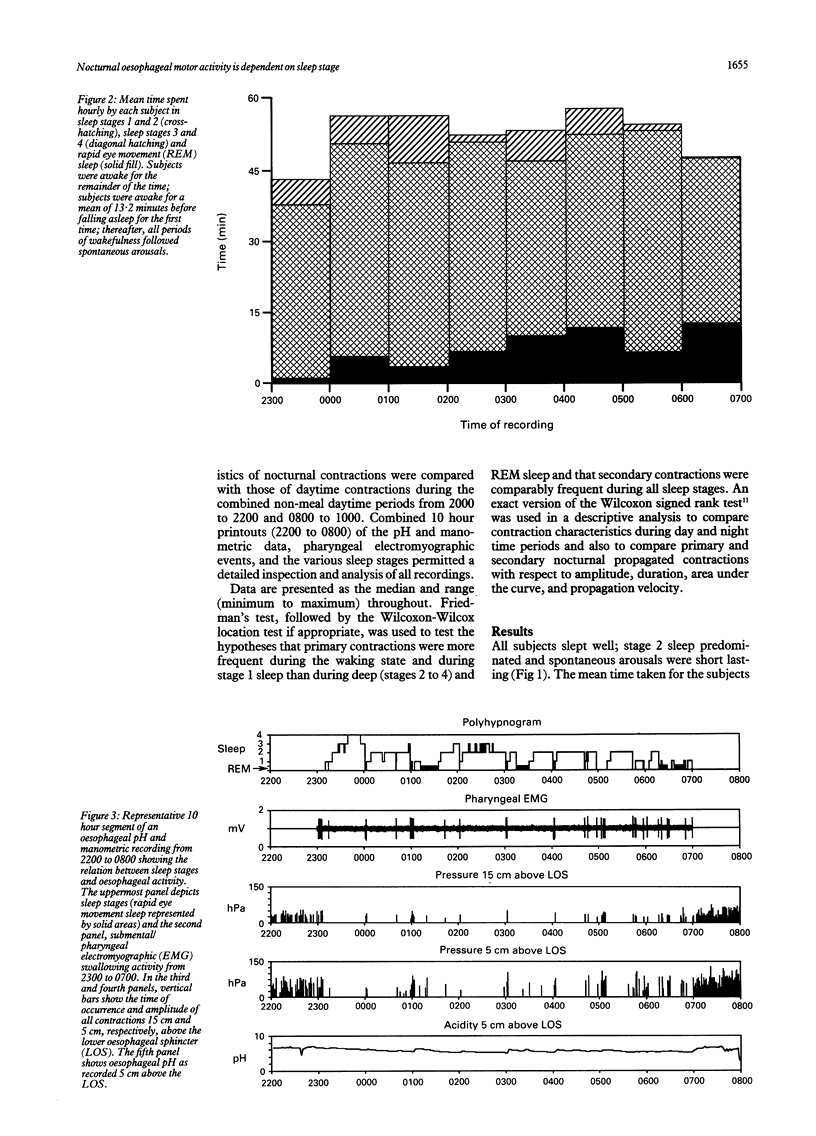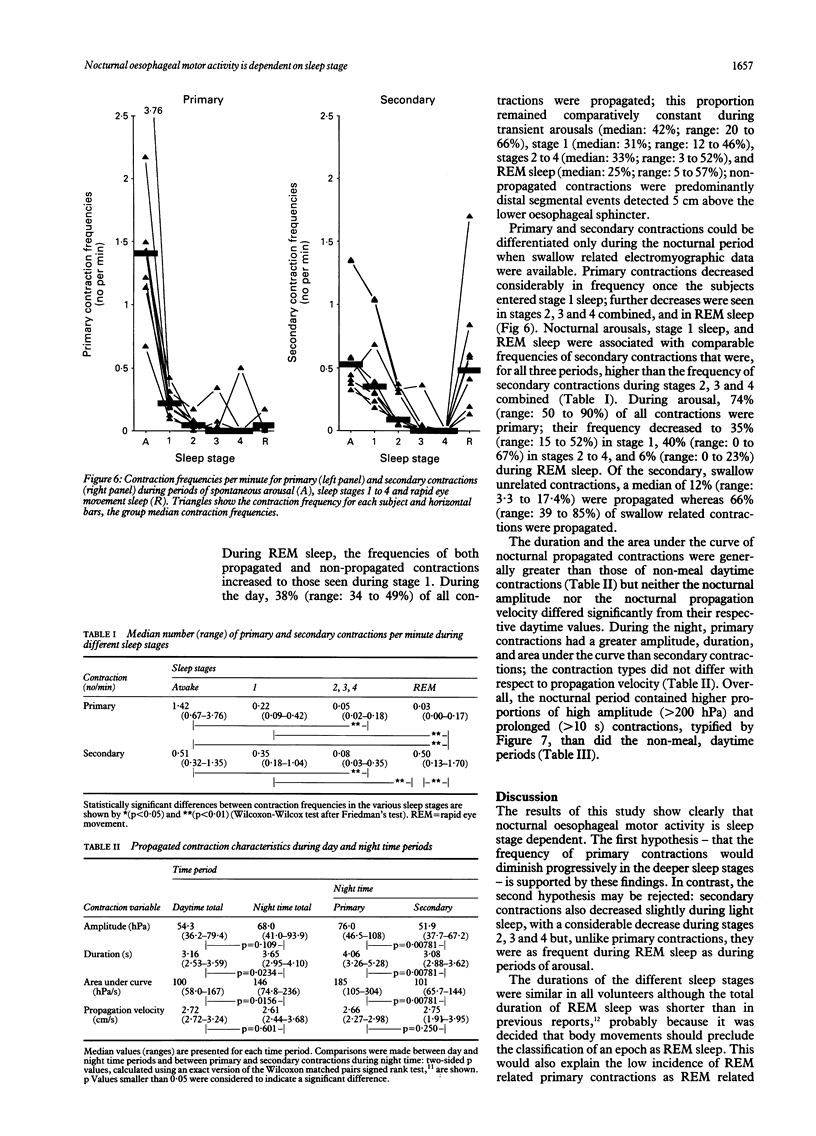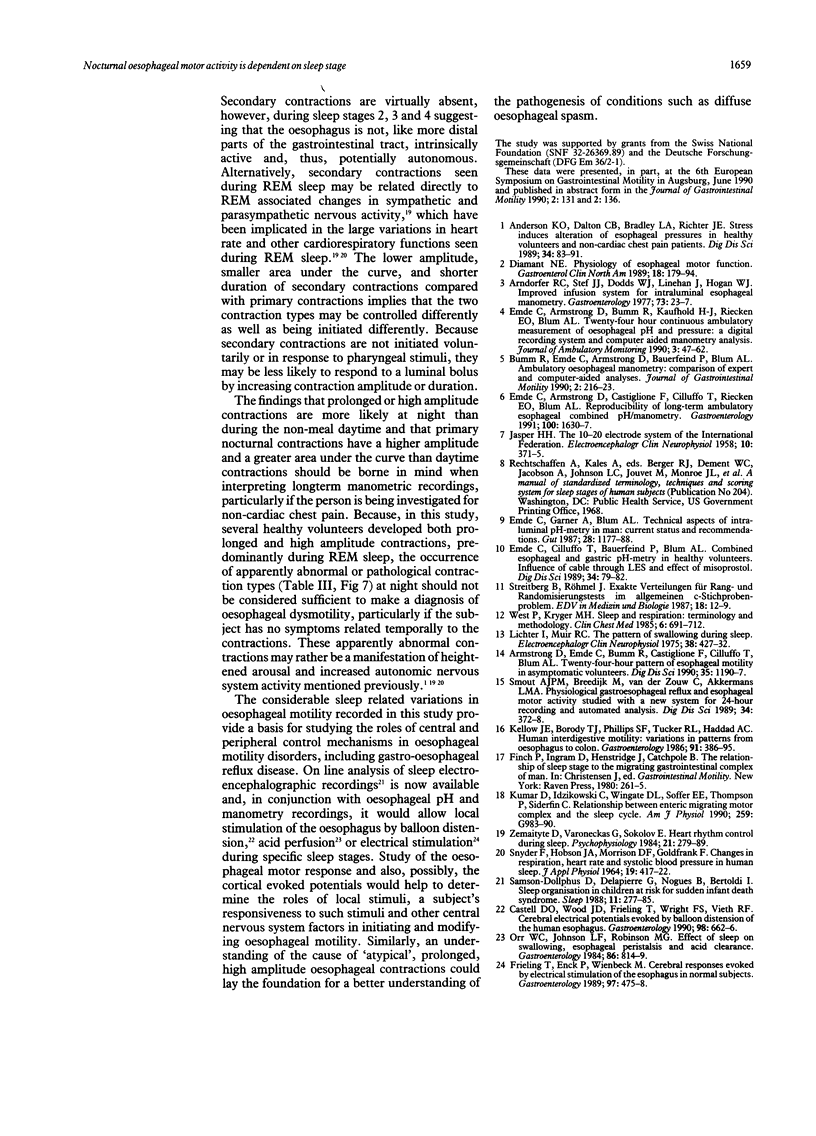Abstract
Simultaneous overnight oesophageal pH and manometric and sleep electroencephalographic recordings were performed in eight healthy subjects, aged 20-38 years, to test the hypothesis that the frequency of primary, swallow related contractions decreases progressively with deeper sleep stages whereas the frequency of secondary contractions remains constant throughout the night. During the nocturnal period (2300 to 0700), periods of oesophageal motor quiescence were interspersed by clusters of contractions detected 5 and 15 cm above the lower oesophageal sphincter. Primary contractions decreased in frequency from 1.42/min (median) during arousal periods to 0.22/min during stage 1 sleep, 0.05/min during stages 2 to 4 combined, and 0.03/min during rapid eye movement (REM) sleep. Secondary contractions were also most frequent during arousal periods (0.51/min) and they, too, decreased in frequency during stage 1 (0.35/min) and stages 2 to 4 combined (0.08/min). During REM sleep, however, the frequency of secondary contractions increased (0.50/min) to levels noted during arousal and stage 1 sleep. Compared with primary contractions, secondary contractions had a lower amplitude (51.9 hPa v 76.0 hPa; p = 0.0078) and a shorter duration (3.08 v 4.06 s; p = 0.0078). The results of this study suggest that there is no intrinsic oesophageal motor activity in the absence of a stimulatory input from the central nervous system and that the increased number of secondary contractions during REM sleep may be a result of an REM related increase in autonomic nervous system activity although a temporary decrease of efferent inhibitory influences cannot be ruled out. Nocturnal contraction clusters comprise both primary contractions during arousals and stage 1 sleep and secondary contractions during REM sleep.
Full text
PDF






Selected References
These references are in PubMed. This may not be the complete list of references from this article.
- Anderson K. O., Dalton C. B., Bradley L. A., Richter J. E. Stress induces alteration of esophageal pressures in healthy volunteers and non-cardiac chest pain patients. Dig Dis Sci. 1989 Jan;34(1):83–91. doi: 10.1007/BF01536159. [DOI] [PubMed] [Google Scholar]
- Armstrong D., Emde C., Bumm R., Castiglione F., Cilluffo T., Blum A. L. Twenty-four-hour pattern of esophageal motility in asymptomatic volunteers. Dig Dis Sci. 1990 Oct;35(10):1190–1197. doi: 10.1007/BF01536406. [DOI] [PubMed] [Google Scholar]
- Arndorfer R. C., Stef J. J., Dodds W. J., Linehan J. H., Hogan W. J. Improved infusion system for intraluminal esophageal manometry. Gastroenterology. 1977 Jul;73(1):23–27. [PubMed] [Google Scholar]
- Castell D. O., Wood J. D., Frieling T., Wright F. S., Vieth R. F. Cerebral electrical potentials evoked by balloon distention of the human esophagus. Gastroenterology. 1990 Mar;98(3):662–666. doi: 10.1016/0016-5085(90)90286-a. [DOI] [PubMed] [Google Scholar]
- Diamant N. E. Physiology of esophageal motor function. Gastroenterol Clin North Am. 1989 Jun;18(2):179–194. [PubMed] [Google Scholar]
- Emde C., Armstrong D., Castiglione F., Cilluffo T., Riecken E. O., Blum A. L. Reproducibility of long-term ambulatory esophageal combined pH/manometry. Gastroenterology. 1991 Jun;100(6):1630–1637. doi: 10.1016/0016-5085(91)90662-5. [DOI] [PubMed] [Google Scholar]
- Emde C., Cilluffo T., Bauerfeind P., Blum A. L. Combined esophageal and gastric pH-metry in healthy volunteers. Influence of cable through LES and effect of misoprostol. Dig Dis Sci. 1989 Jan;34(1):79–82. doi: 10.1007/BF01536158. [DOI] [PubMed] [Google Scholar]
- Emde C., Garner A., Blum A. L. Technical aspects of intraluminal pH-metry in man: current status and recommendations. Gut. 1987 Sep;28(9):1177–1188. doi: 10.1136/gut.28.9.1177. [DOI] [PMC free article] [PubMed] [Google Scholar]
- Frieling T., Enck P., Wienbeck M. Cerebral responses evoked by electrical stimulation of the esophagus in normal subjects. Gastroenterology. 1989 Aug;97(2):475–478. doi: 10.1016/0016-5085(89)90087-5. [DOI] [PubMed] [Google Scholar]
- Kellow J. E., Borody T. J., Phillips S. F., Tucker R. L., Haddad A. C. Human interdigestive motility: variations in patterns from esophagus to colon. Gastroenterology. 1986 Aug;91(2):386–395. doi: 10.1016/0016-5085(86)90573-1. [DOI] [PubMed] [Google Scholar]
- Kumar D., Idzikowski C., Wingate D. L., Soffer E. E., Thompson P., Siderfin C. Relationship between enteric migrating motor complex and the sleep cycle. Am J Physiol. 1990 Dec;259(6 Pt 1):G983–G990. doi: 10.1152/ajpgi.1990.259.6.G983. [DOI] [PubMed] [Google Scholar]
- Lichter I., Muir R. C. The pattern of swallowing during sleep. Electroencephalogr Clin Neurophysiol. 1975 Apr;38(4):427–432. doi: 10.1016/0013-4694(75)90267-9. [DOI] [PubMed] [Google Scholar]
- Orr W. C., Johnson L. F., Robinson M. G. Effect of sleep on swallowing, esophageal peristalsis, and acid clearance. Gastroenterology. 1984 May;86(5 Pt 1):814–819. [PubMed] [Google Scholar]
- SNYDER F., HOBSON J. A., MORRISON D. F., GOLDFRANK F. CHANGES IN RESPIRATION, HEART RATE, AND SYSTOLIC BLOOD PRESSURE IN HUMAN SLEEP. J Appl Physiol. 1964 May;19:417–422. doi: 10.1152/jappl.1964.19.3.417. [DOI] [PubMed] [Google Scholar]
- Samson-Dollfus D., Delapierre G., Nogues B., Bertoldi I. Sleep organization in children at risk for sudden infant death syndrome. Sleep. 1988 Jun;11(3):277–285. doi: 10.1093/sleep/11.3.277. [DOI] [PubMed] [Google Scholar]
- Smout A. J., Breedijk M., van der Zouw C., Akkermans L. M. Physiological gastroesophageal reflux and esophageal motor activity studied with a new system for 24-hour recording and automated analysis. Dig Dis Sci. 1989 Mar;34(3):372–378. doi: 10.1007/BF01536258. [DOI] [PubMed] [Google Scholar]
- West P., Kryger M. H. Sleep and respiration: terminology and methodology. Clin Chest Med. 1985 Dec;6(4):691–712. [PubMed] [Google Scholar]
- Zemaityte D., Varoneckas G., Sokolov E. Heart rhythm control during sleep. Psychophysiology. 1984 May;21(3):279–289. doi: 10.1111/j.1469-8986.1984.tb02935.x. [DOI] [PubMed] [Google Scholar]


